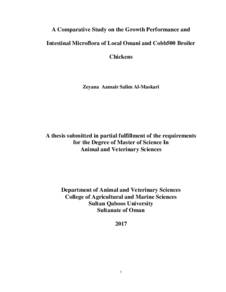وثيقة
A comparative study on the growth performance and intestinal microflora of local Omani and cobb500 broiler chickens
الناشر
Sultan Qaboos University
ميلادي
2017
اللغة
الأنجليزية
الموضوع
الملخص الإنجليزي
Local Omani chickens, although well adapted to the climatic conditions of the Sultanate of Oman are poor performance when compared to breeds such as the Cobb 500 broiler chickens. Two experiments were conducted to compare the growth performance and the composition of intestinal microflora between local Omani and Cobb500 broiler chickens maintained under an intensive management system. The main objective of the first experiment was to compare the growth performance of local Omani and Cobb500
broiler chickens raised under intensive management system. One hundred and eighty birds of local Omani and Cobb500 broiler chickens were divided into two groups with fifteen replicates, each replicate containing six birds. The birds were fed a non-
medicated conventional corn-soybean meal diet. Feed intake, body weight gain, and feed conversion ratio were recorded weekly. At the end of the growth experiment period (35 days), fifteen birds per breed were randomly selected for morphological analysis of the
jejunum and ileum, carcass and organs weight. Blood was collected for hematological and serum biochemistry analysis. Hematological and serum analysis showed that there was no significant difference between Omani and Cobb 500 broiler suggesting that the
birds are healthy. Morphological analysis showed that Cobb 500 broiler had greater villi height compared to the Omani breed (P<0.01) and subsequently a significantly higher feed intake (63.8%), significantly higher body weight gains (72.1%) better feed conversion ratios than the Omani breed (1.50 vs 1.96). However, local Omani chicken have significantly heavier relative organ weights (p<0,001) In the second experiment, 16S rDNA-based analysis was employed to explore the effect non-medicated conventional corn-soybean meal diet on the bacterial communities in the gastrointestinal tract of the two breeds of chickens. This study showed that optimal development of the small intestinal is associated with a preponderance of Bacilli (98%) in the duodenum at Day 5 of Cobb500 chickens and that the inferior growth rate of the local Omani chickens was assumed to be related to the smaller number of Bacilli
(68.5%) in their Duodenum at Day 5. The large number (25.8%) of the fermenting bacteria, Clostridia in the duodenum at
Day5 in the local Omani chickens versus 0.88% in the duodenum of the Cobb500 was postulated to be associated with inferior development of the small intestine and subsequently, inferior nutrient digestion and absorption.
المجموعة
URL المصدر
الملخص العربي
على الرغم من أن الدجاج العماني، متكيف بشكل جيد مع الظروف المناخية السلطنة عمان، إلا أنه ضعيف الأداء بالمقارنة مع بعض سلالات الدجاج اللاحم مثل Cobb500. أجريت تجريتان لمقارنة النمو وتكوين البكتيريا الدقيقة بين الدجاج العماني المحلى و Cobb500 تحت نظام الإدارة المكتق وكان الهدف الرئيسي من التجربة الأولى مقارنة أداء الدجاج العملي المحلي واللحم Cobb500 تت نظام الإدارة المكثف. تم تقسيم مائة وثمانين طبرا من الدجاج العماني المحلي و ال Cobb500 إلى مجموعتين مع خمسة عشر مكرر ، يحتوي كل منها على ستة طيور . وتم تغذية الطيور بعليقة مبسطة خالية من أي اضافات وهي جبة الذرة فول الصويا النظام الغذائي. وتم تسجيل كمية التغذية، وزيادة وزن الجسم، ومعدل تحويل العلف أسبوعيا. في نهاية قرة تجربة النمو (35 يوما)، تم اختيار 15 طير عشوائيا للتحليل النسيجي لتمعاء الدقيقة والأمعاء الغليظة ( Ileuum and Jejunuum )روزن الذبيحة وأعضاء الجسم ، تم جمع الدم لتحليل الدم و الكيمياء الحيوية في الدم. أظهر تحليل الدم والمصل الى عدم وجود فرق معنوي بين الدجاج العماني وCobb500 مما يدل على أن الطيور كانت سليمة. وأظهر التحليل النسيجي أن ( villi) في أن Cobb500 كانت أعلى مقارنة بالسلالة العمانية .( 001 =P وكانت نسبة العلف أعلى بكثير ( %63 . 8 ). وارتفعت نسب التغذية بشكل أفضل (72. 1 %) عن السلالة العمانية ( 1, 50 مقابل 1 ,96). ومع ذلك، فإن الدواجن العمانية المحلية كانت أنتقل نسبيا بالنسبة للأوزان النسبية ( 0. 001=P)
في التجربة الثانية، ثم استخدام تحليل يستند إلى 16S rDNA لاستكشاف تاتير نظام غذائي فول الصويا وجبة الذرة التقليدية غير المعالجة على المجتمعات البكتيرية في الجهاز الهضمي من سنتين من الدجاج. وأظهرت هذه الدراسة أن النمو الأمثل لتثنی عشر (Diodentim)كان مرتبطا باحتمال وجود أكبر للعصيات Bacilli ( %98) في اليوم الخامس من عمر الطير في من الاثني عشر (Duodenum) في الدجاج Cobb500 ونسبة نمو أقل من الدجاج العماني المحلي كان من المفترض أن تكون مرتبطة يعد أصغر من الياسية(Bacili) ( %68 .5 ) في المعي الاتني عشرة (Diodetitum في اليوم الخامس وجدت نسبة (25 . 8 %) من البكتريا المخمرة، كلوستريسيا( Clostridia )في الاثني عشر في يوم الخامس في الدجاج العمانية المحلية مقارنة مع 0 . 88% في الاثني عشر من Cobb500 ،مما قد يفسر ضعف تطور الأمعاء الدقيقة وهضم المغذيات و الامتصاص في النجاح العملي المطي.
في التجربة الثانية، ثم استخدام تحليل يستند إلى 16S rDNA لاستكشاف تاتير نظام غذائي فول الصويا وجبة الذرة التقليدية غير المعالجة على المجتمعات البكتيرية في الجهاز الهضمي من سنتين من الدجاج. وأظهرت هذه الدراسة أن النمو الأمثل لتثنی عشر (Diodentim)كان مرتبطا باحتمال وجود أكبر للعصيات Bacilli ( %98) في اليوم الخامس من عمر الطير في من الاثني عشر (Duodenum) في الدجاج Cobb500 ونسبة نمو أقل من الدجاج العماني المحلي كان من المفترض أن تكون مرتبطة يعد أصغر من الياسية(Bacili) ( %68 .5 ) في المعي الاتني عشرة (Diodetitum في اليوم الخامس وجدت نسبة (25 . 8 %) من البكتريا المخمرة، كلوستريسيا( Clostridia )في الاثني عشر في يوم الخامس في الدجاج العمانية المحلية مقارنة مع 0 . 88% في الاثني عشر من Cobb500 ،مما قد يفسر ضعف تطور الأمعاء الدقيقة وهضم المغذيات و الامتصاص في النجاح العملي المطي.
قالب العنصر
الرسائل والأطروحات الجامعية

